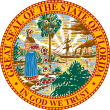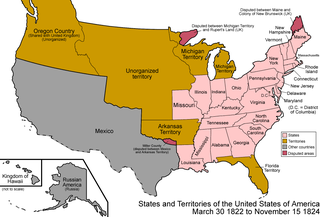It has been requested that the title of this article be changed to List of governors of Florida . Please see the relevant discussion on the discussion page. The page should not be moved unless the discussion is closed; summarizing the consensus achieved in support of the move. |
| Governor of Florida | |
|---|---|
 | |
| Style | The Honorable |
| Residence | Florida Governor's Mansion |
| Term length | Four years, renewable once |
| Inaugural holder | William Dunn Moseley |
| Formation | June 25, 1845 |
| Deputy | Jeanette Nunez, lieutenant governor |
| Salary | $130,273 (2013) [1] |
| Website | www |
The Governor of Florida is the head of the executive branch of Florida's state government and the commander-in-chief of the state's military forces. [2] The governor has a duty to enforce state laws, and the power to either approve or veto bills passed by the Florida Legislature, [3] to convene the legislature, [4] and to grant pardons, except in cases of impeachment. [5]

The government of Florida is established and operated according to the Constitution of Florida and is composed of three branches of government: the executive branch consisting of the Governor of Florida and the other elected and appointed constitutional officers; the legislative branch, the Florida Legislature, consisting of the Senate and House; and the judicial branch consisting of the Supreme Court of Florida and lower courts. The state also allows direct participation of the electorate by initiative, referendum, and ratification.

A commander-in-chief, sometimes also called supreme commander, is the person that exercises supreme command and control over an armed forces or a military branch. As a technical term, it refers to military competencies that reside in a country's executive leadership – a head of state or a head of government.

The Florida National Guard is the National Guard force of the U.S. state of Florida. It comprises the Florida Army National Guard and the Florida Air National Guard.
Contents
- Governors
- Federal military commissioner
- Governors of the Territory of Florida
- Governors of the State of Florida
- See also
- Notes
- References
When Florida was first acquired by the United States, future President Andrew Jackson served as its military governor. Florida Territory was established in 1822, and five people served as governor over six distinct terms. The first territorial governor, William Pope Duval, served 12 years, the longest of any Florida governor to date.

Andrew Jackson was an American soldier and statesman who served as the seventh president of the United States from 1829 to 1837. Before being elected to the presidency, Jackson gained fame as a general in the United States Army and served in both houses of Congress. As president, Jackson sought to advance the rights of the "common man" against a "corrupt aristocracy" and to preserve the Union.

The Territory of Florida was an organized incorporated territory of the United States that existed from March 30, 1822, until March 3, 1845, when it was admitted to the Union as the state of Florida. Originally the Spanish territory of La Florida, and later the provinces of East and West Florida, it was ceded to the United States as part of the 1819 Adams–Onís Treaty. It was governed by the Florida Territorial Council.

William Pope Duval was the first civilian governor of Florida Territory, succeeding Andrew Jackson, who had been military governor. In his twelve-year governorship, from 1822 to 1834, he divided Florida into four territories, established the local court system, and chose Tallahassee as the territory's capital because of its central location. Duval County, where Jacksonville is located, Duval Street in Key West, and Duval Street in Tallahassee, Florida are named for him.
Since statehood in 1845, there have been 45 people who have served as governor, one of whom served two distinct terms. Four state governors have served two full four-year terms: William D. Bloxham, in two stints; and Reubin Askew, Jeb Bush, and Rick Scott who each served their terms consecutively. Bob Graham almost served two terms, as he resigned with only three days left. The shortest term in office belongs to Wayne Mixson, who served three days following the resignation of his predecessor, Bob Graham.

William Dunnington Bloxham was the 13th and 17th Governor of Florida in two non-consecutive terms. Prior to his first term as governor, he served in the Florida House of Representatives.

Reubin O'Donovan Askew was an American politician, who served as the 37th Governor of the U.S. state of Florida from 1971 to 1979. He led on tax reform, civil rights, and financial transparency for public officials, maintaining an outstanding reputation for personal integrity.

John Ellis "Jeb" Bush is an American politician who served as the 43rd Governor of Florida from 1999 to 2007. Bush, who grew up in Houston, is the second son of former President George H. W. Bush and former First Lady Barbara Bush, and a younger brother of former President George W. Bush. He graduated from Phillips Academy in Andover, Massachusetts, and attended the University of Texas, where he earned a degree in Latin American affairs. In 1980, he moved to Florida and pursued a career in real estate development, and in 1986 became Florida's Secretary of Commerce until 1988. At that time, he joined his father's successful campaign for the Presidency.
The current governor is Ron DeSantis, a member of the Republican Party who took office on January 8, 2019.

Ronald Dion DeSantis is an American attorney, former Naval officer, and politician serving as the 46th governor of Florida since January 2019. A Republican, he represented Florida's 6th congressional district in Congress from 2013 to 2018. After graduating from Yale University and Harvard Law School, DeSantis served as an officer and attorney in the Judge Advocate General's Corps, U.S. Navy (JAG).

The Republican Party, also referred to as the GOP, is one of the two major political parties in the United States; the other is its historic rival, the Democratic Party.


























































